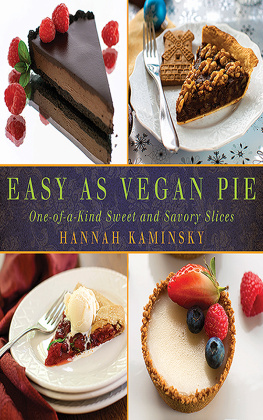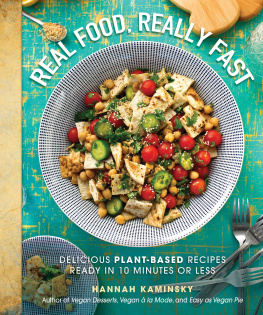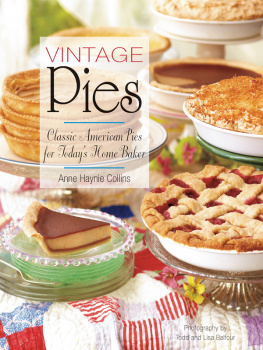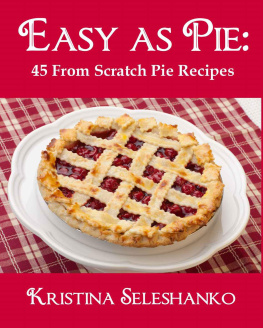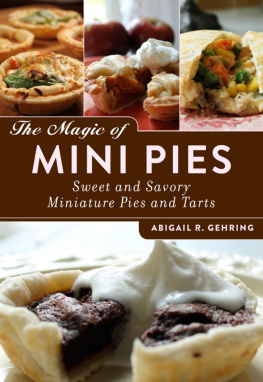INTRODUCTION
W hy pie? That very question rattled through my head, day after day...
It would be foolish and quite arrogant to claim that an exhaustive, be-all, end-all tome on the subject could come from my hands. Few baked goods carry as much history, or such emotional weight, as pie, with recipes passed down through generations of mothers, sisters, fathers, and brothers. No one will make a pie quite as good as one prepared by a loved one. I dont think that one single book could ever cover all aspects of pies, from their myriad forms and shapes, to the most creative fillings, to that elusive secret formula for the best crust. No, no such book can honestly exist, so the tome you hold in your hands isnt it... But its my take on the noble pie. I may not have learned to roll out pie dough at my grandmothers knee, or honed my skills through years of practice, but its never too late to pick up a few new tricks.
Pie should never be intimidating or seem out of reach, even to the most inexperienced of bakers. Thats why Id argue that if I, someone so far outside the pie-making fold, can roll with the best of them, anyone else can, too. Its time to end the stereotype that merely making crust can bring newcomers to their knees, placing pies on an unattainable pedestal that scares away those who simply hunger for a slice of comfort. Bring pie back to the table where it belongs, accessible to anyone with the desire to throw down a bit of flour and watch it transform by way of some ancient alchemy into something delicious in the oven.
Take the following instructions with a pinch of salt, and sugar if your sweet tooth does so implore, because no recipe should be set in stone. Experiment fearlessly, fail brilliantly, and succeed with as flamboyant a victory dance as you like. Pie is a dish meant for sharing, so make sure that above all else, you have plenty of company to share your work. Nothing will win new friends like a generous slice of freshly baked pie.

INGREDIENTS GLOSSARY
Agave Nectar
D erived from the same plant as tequila but far less potent, this nectar is the sweet syrup at the core of the agave cactus. It is available in both light and dark varieties; the dark possesses a more nuanced, complex, and somewhat floral flavor, while the light tends to provide only a clean sweetness. Unrefined, agave nectar has a much lower glycemic index than many traditional granulated sweeteners, and is therefore consumed by some diabetics in moderation. Any health food or natural food store worth its stuff should stock agave nectar.
Agar (Agar-Agar)
Known also as kanten, agar is a gelatinous substance made out of seaweed. It is a perfect substitute for traditional gelatin, which is extracted from the collagen within animals connective tissues and obviously extremely not vegan. Agar comes in both powdered and flaked form. I prefer to use the powder because it is easier to incorporate smoothly into puddings, faster to thicken, and measures gram for gram like standard gelatin. However, if you can only find the flakes, just whiz them in a spice grinder for a few minutes andvoila, instant agar powder! Agar can be found in Asian markets and some health food stores.
All-Purpose Flour
While wonderful flours can be made from all sorts of grains, beans, nuts, and seeds, the gold standard in everyday baking would be all purpose wheat flour. Falling texturally somewhere in between cake flour and bread flour, all-purpose flour has the ability to create light desserts which still have substance. It is therefore used most often in my recipes, and stocked as one of my pantry staples. All-purpose flour may be labeled in stores as unbleached white flour or simply plain flour.
Almond Meal /Flour
Almond flour is the end result of grinding down raw almonds into a fine powder; almond meal is generally a bit coarser. To make your own, just throw a pound or so of completely unadulterated almonds into your food processor, and let the machine work its magic. Due to their high oil content, ground nuts can go rancid fairly quickly. If you opt to stock up and save some for later, be sure to store the freshly ground almond flour in an airtight container in the refrigerator or freezer. To cut down on labor and save a little time, almond flour or meal can be purchased in bulk from natural food stores.
Alum
A throwback to the olden days of food preservation, alum is mainly used for pickling fruits and vegetables, to keep foods crisp in texture and fresh in taste. Still available right next to the allspice in all major grocery stores, its a potent salt (like sodium or potassium) which must always be used sparingly, as it can prove toxic if ingested in large doses (over 1 ounce at a time.) If the sound of that makes you nervous, feel free to omit the alum when called for. It carries a certain astringent, acidic taste thats hard to describe, but you wont miss it too much if youve never used it in the first place.
Apple Cider Vinegar
As with oil, vinegar can be made from all sorts of fruits, grains, and roots, which all create unique flavor profiles and chemical compositions in the finished product. Thinking along these lines, apple cider vinegar could be considered the olive oil of vinegars; flavorful, useful, and an all-around great thing to have on hand. Regular white wine vinegar or the other standard options would certainly work, but the distinctive twang of apple cider vinegar rounds out baked goods so perfectly, and it is so easy to find... why wouldnt you use it? Hunt around the oil and salad dressing aisles in your local supermarket, where you should have no problem securing a bottle.

